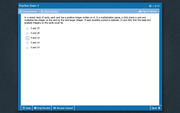
Thanks.
Play with the answer choices. Say we test B. If the smallest card were 3, and the game involves multiplying the card by the next integer, we'd multiply 3 by 4, and get 3*4 =12. But we know every possible product is between 15 and 200. 12 isn't in that range, so 3 can't be the smallest card in the deck.In a certain deck of cards, each card has a positive integer written on it, in a multiplication game a child draws a card and multiplies the integer on the card with the next large integer. If the each possible product is between 15 and 200, then the least and greatest integer on the card would be
A) 3 and 15
B) 3 and 20
C) 4 and 13
D) 4 and 14
E) 5 and 14
We can PLUG IN THE ANSWERS, which represent the least and greatest integers on the cards.In a certain deck of cards, each card has a positive integer written on it. In a multiplication game, a child draws a card and multiplies the integer on the card by the next larger integer. If each possible product is between 15 and 200, then the least and greatest integers on the cards could be
A. 3 and 15
B. 3 and 20
C. 4 and 13
D. 4 and 14
E. 5 and 14